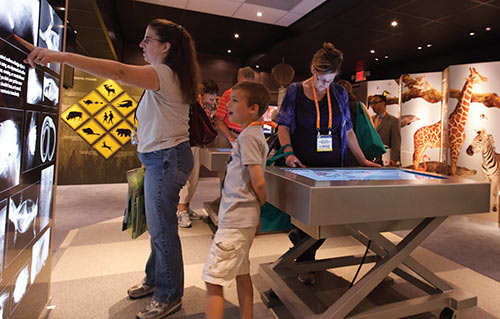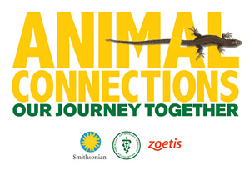Smithsonian exhibition shows veterinarians’ roles

A traveling exhibition shows visitors how veterinary medicine affects their lives, and describes the bond between humans and animals.
Anna R. Cohn, director of the Smithsonian Institution Traveling Exhibition Service, said the exhibition, “Animal Connections: Our Journey Together,” will share knowledge with young people “who deserve to be inspired by the contributions veterinarians and veterinary medicine make every day of every year.”
 The traveling exhibition debuted July 20 in the McCormick Place exhibit hall at the AVMA Annual Convention. The AVMA and Zoetis collaborated with the Smithsonian on developing the exhibition in time for the AVMA’s 150th anniversary year.
The traveling exhibition debuted July 20 in the McCormick Place exhibit hall at the AVMA Annual Convention. The AVMA and Zoetis collaborated with the Smithsonian on developing the exhibition in time for the AVMA’s 150th anniversary year.
“In a mere 1,000 square feet, it opens our eyes, as it will for everyone who visits it, to the fact that animal health is directly tied to our own well-being, and it is veterinarians who are the active partners in ensuring a shared health globally,” Cohn said.
The exhibition is tailored to middle school–age audiences and their families, she said.
It was created to inspire the next generation of veterinarians, according to the exhibition website. It lets visitors explore topics involving animals in homes, on farms, in the wild, in zoos, and in veterinary clinics.
Dr. Douglas G. Aspros, 2012-2013 AVMA president, described the exhibition as a “dream come true,” and he praised it for including information on a broad scope of veterinary practice areas that work for the betterment of patients, owners, and society. He hopes the exhibition will motivate members of the public to examine how veterinary medicine intersects with their lives.
He said that when he heard the proposal to develop the exhibition at least five years ago, “It was a dream that seemed to me unlikely to happen.”
The AVMA wanted to bring attention to veterinary medicine, both for those who use veterinary services and for young people who could learn more about veterinarians and become interested in the profession, Dr. Aspros said.
On the morning the exhibition was unveiled, he smiled as he looked over the displays inside.
“I’m proud to be a veterinarian, and, standing in this room, you can see the diversity of the professional activities of our members,” he said. “And it’s cool.”
After the AVMA Annual Convention, the Smithsonian planned to bring the exhibition to seven parks in Chicago, Cohn said. The next destinations were not yet announced, but the attraction will travel throughout the U.S.
“The exhibit has captured tremendous interest, and it’s in very high demand,” she said.
It could visit up to 45 sites annually, she said, including veterinary schools, state fairs, 4H and National FFA meetings, middle schools, parks, and community centers.
The Smithsonian operates the world’s largest traveling exhibition service, and about 50 of its traveling exhibitions circulate yearly, Cohn said.
Dr. Aspros said the AVMA encourages members to volunteer to help educate the public when the exhibition moves into areas where they live.
J.B. Hancock, director of the AVMA Communications Division, said work on the Smithsonian project spanned eight years and many iterations, ending with a gratifying product “more impressive and engaging than we imagined.”
“While we were only able to scratch the surface of all the ways in which veterinary medicine affects our lives every day, we hope the traveling exhibit will be a catalyst that inspires visitors to seek out more information about this wonderful profession and its role in society,” she said.
Visit the exhibition website.